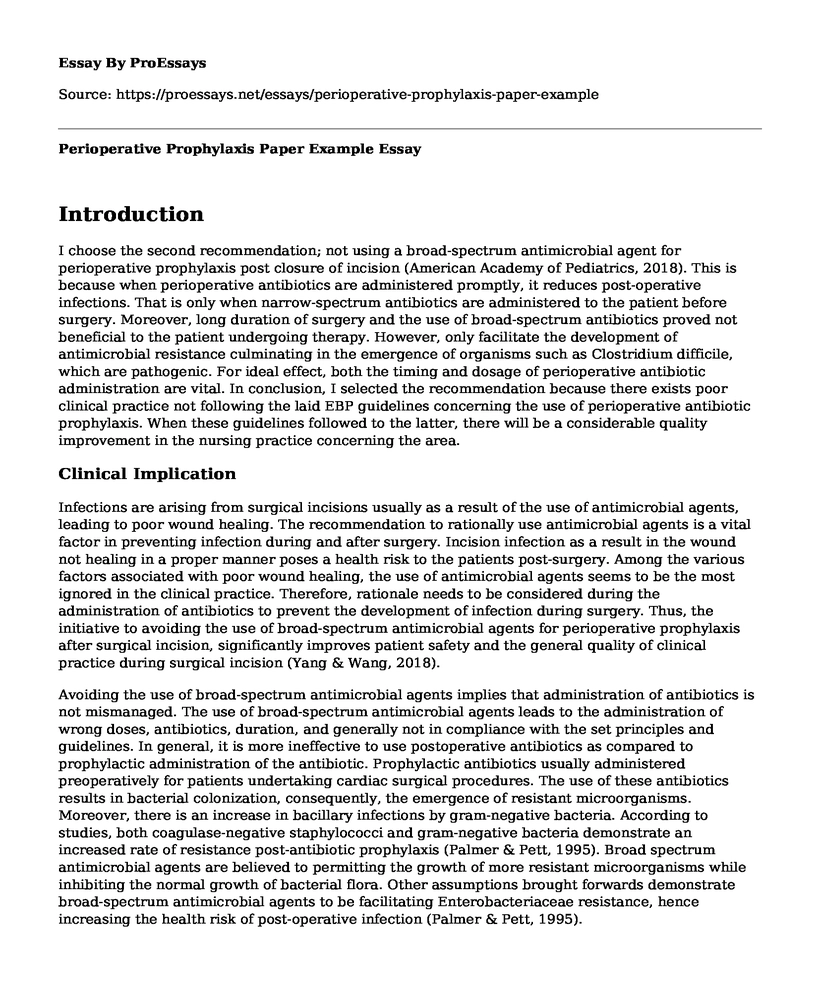Introduction
I choose the second recommendation; not using a broad-spectrum antimicrobial agent for perioperative prophylaxis post closure of incision (American Academy of Pediatrics, 2018). This is because when perioperative antibiotics are administered promptly, it reduces post-operative infections. That is only when narrow-spectrum antibiotics are administered to the patient before surgery. Moreover, long duration of surgery and the use of broad-spectrum antibiotics proved not beneficial to the patient undergoing therapy. However, only facilitate the development of antimicrobial resistance culminating in the emergence of organisms such as Clostridium difficile, which are pathogenic. For ideal effect, both the timing and dosage of perioperative antibiotic administration are vital. In conclusion, I selected the recommendation because there exists poor clinical practice not following the laid EBP guidelines concerning the use of perioperative antibiotic prophylaxis. When these guidelines followed to the latter, there will be a considerable quality improvement in the nursing practice concerning the area.
Clinical Implication
Infections are arising from surgical incisions usually as a result of the use of antimicrobial agents, leading to poor wound healing. The recommendation to rationally use antimicrobial agents is a vital factor in preventing infection during and after surgery. Incision infection as a result in the wound not healing in a proper manner poses a health risk to the patients post-surgery. Among the various factors associated with poor wound healing, the use of antimicrobial agents seems to be the most ignored in the clinical practice. Therefore, rationale needs to be considered during the administration of antibiotics to prevent the development of infection during surgery. Thus, the initiative to avoiding the use of broad-spectrum antimicrobial agents for perioperative prophylaxis after surgical incision, significantly improves patient safety and the general quality of clinical practice during surgical incision (Yang & Wang, 2018).
Avoiding the use of broad-spectrum antimicrobial agents implies that administration of antibiotics is not mismanaged. The use of broad-spectrum antimicrobial agents leads to the administration of wrong doses, antibiotics, duration, and generally not in compliance with the set principles and guidelines. In general, it is more ineffective to use postoperative antibiotics as compared to prophylactic administration of the antibiotic. Prophylactic antibiotics usually administered preoperatively for patients undertaking cardiac surgical procedures. The use of these antibiotics results in bacterial colonization, consequently, the emergence of resistant microorganisms. Moreover, there is an increase in bacillary infections by gram-negative bacteria. According to studies, both coagulase-negative staphylococci and gram-negative bacteria demonstrate an increased rate of resistance post-antibiotic prophylaxis (Palmer & Pett, 1995). Broad spectrum antimicrobial agents are believed to permitting the growth of more resistant microorganisms while inhibiting the normal growth of bacterial flora. Other assumptions brought forwards demonstrate broad-spectrum antimicrobial agents to be facilitating Enterobacteriaceae resistance, hence increasing the health risk of post-operative infection (Palmer & Pett, 1995).
Therefore, clinical practices need to shift from the use of broad-spectrum to narrow spectrum antimicrobial agent for perioperative prophylaxis as it will enhance patients' safety after surgery. The use of narrow-spectrum antimicrobial agents facilitates a more significant reduction of the chance to carry staphylococcal at the site of operation post-surgery. The use of narrow-spectrum antimicrobial agents should, therefore, be recommended in all surgical operations unless cases of resistance by nosocomial bacteria are noted. The general implication of narrow-spectrum antibiotic prophylaxis is a significant reduction of staphylococci in wounds, preventing the development of resistance by microbes, and general cost of maintaining surgical wounds (Yang & Wang, 2018).
References
American Academy of Pediatrics. (2018). American Academy of Pediatrics - Committee on Infectious Diseases and the Pediatric Infectious Diseases Society | Choosing Wisely. Retrieved from http://www.choosingwisely.org/societies/american-academy-of-pediatrics-committee-on-infectious-diseases-and-the-pediatric-infectious-diseases-society/
Palmer, D., & Pett, S. (1995). Bacterial Wound Colonization After Broad-Spectrum Versus Narrow-Spectrum Antibiotics.
Yang, X., & Wang, H. (2018). Application of antimicrobial drugs in the perioperative surgical incision. Retrieved from https://www.ncbi.nlm.nih.gov/pmc/articles/PMC5797388/
Cite this page
Perioperative Prophylaxis Paper Example. (2022, Nov 07). Retrieved from https://proessays.net/essays/perioperative-prophylaxis-paper-example
If you are the original author of this essay and no longer wish to have it published on the ProEssays website, please click below to request its removal:
- Research Paper on the Algorithm for Monitoring Diabetes
- Essay Sample on Incivility in the Workplace
- COVID-19: Impact on Small Business Supply Chains - Essay Sample
- Essay on Evolving Professionalism in Pharmacy: A Study of Hippocratic Values
- Paper Example on Youths in Crisis: COVID-19's Impact on Young People Worldwide
- Hand, foot & mouth disease in Vietnam: (HC)
- Essay Example on My Journey to Nursing







